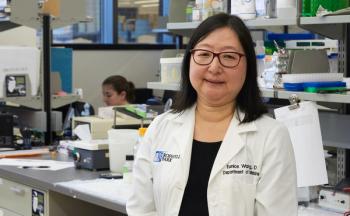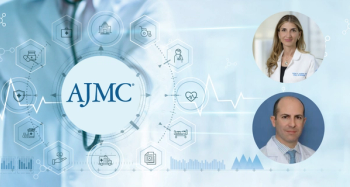
Improving Upon the Oncology Care Model Framework
Transcript:
Bruce Feinberg, DO: It’s a good segue into the future direction. We’ve heard about the Oncology Care Model [OCM] 1.0 and the 2.0, and Ted’s projection that it’s going to keep going and that at some point, we’ll have the Apple Watch version of the OCM. But what would be the 1 thing that, if you could get it tomorrow as part of the OCM, you like to see different from what it currently is?
Richard D. Carvajal, MD: I think I have to say 1 of the clear successes of the OCM is engaging more of the stakeholders in this discussion for value, even just beyond the economics of it. Again, how can we make the experience better for patients? To be honest, that’s how we’re approaching it at our center. This is part of why we wanted to be engaged from the onset, because this was just 1 means for us to advance that end. I do agree, there should be an OCM 2.0, 3.0, 4.0, and 5.0, because in my mind there have already been successes. It’s not perfect at all; no. But there has been progress, and I think for the model, the idea of the value-based pricing, is critical. What I would like to see is just a continuation of this and a continued evolution of this.
Bruce Feinberg, DO: All right, Kavita, what’s your top thing?
Kavita K. Patel, MD, MS: All right. My top thing is that we know the MEOS [monthly enhanced oncology services] payments have worked because everybody unanimously says that. Monthly payments to help pay for this coordination and services doesn’t adequately do it.
Bruce Feinberg, DO: Well, it does only because that was a requirement. You could have required the IOM 13 [Institute of Medicine’s 13-point care-management plan], but nobody would have done it.
Kavita K. Patel, MD, MS: Correct.
Bruce Feinberg, DO: Now, we’ll give you this if you do that.
Kavita K. Patel, MD, MS: Right. So, let’s… I agree with you.
Bruce Feinberg, DO: But I agree.
Kavita K. Patel, MD, MS: But it was a very attractive way, especially for a physician who doesn’t have the ability to get a deep line of equity and just pay for things. It’s a way to keep your practice running while innovating. Take the monthly payments that doctors have said have been extremely helpful to manage day-to-day practice expenses that they otherwise could not manage. Then to actually combine that, to Ted’s point about price prediction, let’s just have some agreement that Medicare went into this to “save money.” Let’s take the aggregate dollars across all the doctors that we think. And I’ve looked at these numbers, but if we think we can save somewhere around $100 billion per year in cancer care by being in a better model, let’s take that dollar amount, and let’s divide it among the number of physicians who are taking care of patients. Let’s just give you almost a global budget and say, “You know what, Bruce, you don’t have to do IOM [Institute of Medicine], but you need to do these basic things. We’re not going to micromanage what those are, but you do them, and you deliver them the way you want to.” In your rural community in Texas, it might be through lay navigators trained at the church. In urban Baltimore, it might be some other model. But don’t prescribe it. Just do it.
Bruce Feinberg, DO: Do you bring up those examples specifically because small and rural practices have really struggled under the OCM?
Kavita K. Patel, MD, MS: Yes, but not just under the OCM; it’s under every alternative payment model. CMS and also many small players tend to take this cookie-cutter approach like, “Here’s our payment model,” and drop it on people. Then they pass it on to the doctors, and we’re just like, “We’ll take it. That sounds great.” Why not flip the script a little bit and let people in. All care is local. We can unanimously agree: all care is local. Let us innovate locally but be held to metric, so we’re not wasting taxpayer dollars.
Bruce Feinberg, DO: Right. I know I can’t limit you just to 1, but I’m going to make a deal.
Ted Okon, MBA: I’ll give you 1.
Bruce Feinberg, DO: All right.
Ted Okon, MBA: Well, I’ll give you 3.
Bruce Feinberg, DO: I knew it. I knew it. I was going to even give him 3, but he couldn’t give me a chance.
Ted Okon, MBA: Price prediction and risk adjustment, but what I’ll give you is attribution, which means that the correct patient is attributed to the practice. Right now, there are too many false positives and negatives.
Bruce Feinberg, DO: You mentioned Florida’s cancer rate, and they’re 9% of the total because of their size, and they’ve got the snowbird population.
Ted Okon, MBA: Right.
Bruce Feinberg, DO: How much is that? Is attribution an issue everywhere else in the country?
Ted Okon, MBA: Attribution is a huge issue. It started out as literally a 40% error rate.
Kavita K. Patel, MD, MS: Huge.
Ted Okon, MBA: This is both in terms of a negative and a positive. Because—you have to understand this, Bruce—you’re talking about claims data. You’re talking about attributing a pay… I’ve heard this over and over again. Let me simplify. A patient is being treated, and they’re on follow-up. Basically all they are is a cancer follow-up, so E/M [evaluation and management]; they’ve had drugs, but all of a sudden they slip and fall and end up in the hospital. It has nothing to do at all with their cancer. I’m not talking about a break attributed to their cancer, bone cancer, or anything like that. I’m talking about somebody goes in the hospital, they have surgery—leading to expense after expense—and all of a sudden, the oncologist gets attributed to that patient. That patient gets attributed to the oncologist. That doesn’t make any sense.
I can tell you right now, as Kavita knows well, there are too many false positives and too many false negatives. There are patients who shouldn’t be attributed to the practice and patients who should be but aren’t. This is a big issue. As much as I said, risk adjustment and price prediction are issues, but this is a fundamental issue. If that’s how you’re getting paid, or if that’s how you’re measuring quality and the patient really isn’t yours, or the patient over here should be yours, that’s a problem.
Bruce Feinberg, DO: All right, Susan, you get the last word on what you’d like to see different. Your first choice of 2.0.
Susan Ash-Lee, MSW, LCSW: Well, I think I’d like 2, since you got 3.
Ted Okon, MBA: Absolutely. Forget how he operates, you’ve got 2.
Bruce Feinberg, DO: I knew I was...
Susan Ash-Lee, MSW, LCSW: Yes. I can’t be upstaged there. First, I think practices need information quicker and faster. Having lag time on their data doesn’t allow them to make changes in any meaningful way. But even more important than that, do we ever talk about the human being and the patient behind all this? In the busyness of clicking boxes and meeting KPIs [key performance indicators], I think that what often gets missed is the human. You talked about it a little earlier—what does value even mean? Do we attribute their value when we’re making a treatment decision and when we’re offering full-scale care? That is the 1 thing that I still think is behind because it has taken so much work for practices just to get the infrastructure in place to be able to collect and report data and then understand their data, that we still have forgotten the human, which is why we went into this care in the first place, right? I guess that’s my No 1.
Ted Okon, MBA: Let me just dovetail off that and say, “Look, let’s talk reality now.” The whole idea—and I take nothing away from CMS and the CMMI [Center for Medicare & Medicaid Innovation] team. The OCM team has been fabulous working on this and has been dedicated to it. But from a big perspective, this is about trying to save money. This is not about trying to do a better job delivering cancer care. It’s about, from the perspective of the government, how do we save money? That’s a little bit of a problem because when the focus is just on…
Bruce Feinberg, DO: I’m not defending anyone, but the point that could be made is that a significant component of that government think tank is that if we improve quality, we will save money.
Ted Okon, MBA: How often has the government made a change in either the reimbursement system or something related to money—Kavita can tell you this a lot better than I can—that has had an unintended consequence that has actually cost money and actually lowered quality. The problem is—I’m not unduly criticizing, I’m just saying—these are the kinds of things we have to think about. In fact, what should happen right now? What, from the CMS and CMMI perspective, should be happening? We’re certainly going to do it—it’s taking all this wonderful learned knowledge that the practices have literally transformed and say, “What have we learned about this? What have we done in terms of making cancer care better?”
Yes, the money component is important. Yes, the price of drugs is critical; it’s unsustainable on its current trajectory. But what can we learn, and what should we do differently? That has to happen as well too. Although the OCM team has done a great job and CMMI has as the innovation center, sometimes government agencies, as literally the providers, don’t exactly meet because you also get in these legal and regulatory regulations to keep them apart.
Newsletter
Stay ahead of policy, cost, and value—subscribe to AJMC for expert insights at the intersection of clinical care and health economics.









































